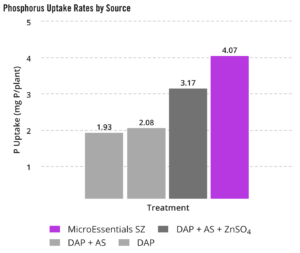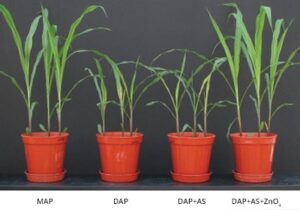OVERVIEW
- Balanced crop nutrition is critical for corn production.
- MicroEssentials® SZ® supplies nitrogen, phosphorus, sulfur and zinc in one nutritionally-balanced granule.
- The MicroEssentials® proprietary Fusion® technology process creates a unique chemistry that results in increased nutrient uptake and crop yield compared to alternative sources.
TRIAL DETAILS
Crop: Corn (Zea mays)
Year: 2013
Location: Sabanci University, Turkey
Data Source: Dr. Ismail Cakmak
Experimental Design: Pot trials conducted under greenhouse conditions on a clay loam soil.
Cropping Conditions:
Treatments: MicroEssentials® SZ®, DAP + AS + ZnSO₄, DAP + AS, DAP
Study Details: All sulfur in the blend was supplied in the sulfate form.
Fertilizers were homogeneously mixed with the soil, simulating broadcast incorporation.
Corn above-ground dry matter and nutrient uptake were determined 20 days after planting.
RESULTS


SUMMARY
- Corn phosphorus uptake was significantly higher for MicroEssentials® SZ® than any other treatment.
- MicroEssentials® SZ® increased P uptake by 28% compared to the DAP + AS + ZnSO₄ blend.
- MicroEssentials® SZ® resulted in a 100% phosphorus uptake increase compared to DAP and the DAP + AS blend.
- Through the MicroEssentials® proprietary Fusion® manufacturing process, nitrogen, phosphorus, sulfur and zinc are combined into one nutritionally balanced granule—creating a single source for balanced crop nutrition.
- The unique formulation of MicroEssentials® SZ® increases phosphorus uptake.